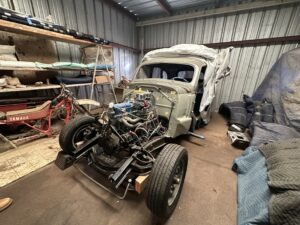
This 1937 Chevrolet Master VIN Verification was done by our team member in Riverside, Ca. on 2-14-2025

This 1937 Chevrolet Master VIN Verification was done by our team member in Riverside, Ca. on 2-14-2025
The 1937 Chevrolet Master was part of Chevrolet’s Master series, offering a sleek design, impressive performance, and remarkable value for its time. Known for its smooth ride and reliable build, the Master represented an important step in the evolution of mid-range vehicles in the late 1930s. As a part of the General Motors lineup, the 1937 Chevrolet Master gained popularity for its quality craftsmanship and innovation in design and technology, positioning itself as a desirable vehicle in the pre-war era.
The Chevrolet Master line was introduced in 1933 as part of Chevrolet’s effort to compete more directly with Ford and other automakers during the Great Depression. The 1937 model year marked the Master’s fifth iteration and reflected significant advancements in automotive engineering. Chevrolet aimed to offer an affordable car that could provide the modern styling, comfort, and performance that consumers were seeking. The 1937 Master was part of a broader move toward streamlining design and improving driving dynamics during the late 1930s, just before the onset of World War II, which would significantly impact the automotive industry.
The 1937 Chevrolet Master was powered by a 216.5 cubic-inch inline-six engine, which provided a solid 85 horsepower. This engine was mated to a 3-speed manual transmission, offering smooth acceleration and adequate performance for everyday driving. The engine’s design was centered on reliability and simplicity, allowing the Master to perform well in a variety of conditions. With a top speed of around 65 mph, it was considered a strong contender in its class at the time. The Master’s smooth ride was further enhanced by its independent front suspension and rear leaf spring setup, providing good handling for a car of its era.
The 1937 Chevrolet Master’s design was a perfect blend of functional elegance and innovation for its time. The car featured a streamlined, rounded body with a lower, wider stance that gave it a more modern appearance compared to earlier models. The highly styled front grille with a V-shaped design, along with the swept-back fenders, created a sophisticated aesthetic. The suicide doors (rear-opening doors) were a notable design feature, providing easier access to the back seats. Inside, the 1937 Chevrolet Master offered a spacious cabin, with a well-appointed dashboard, cloth upholstery, and a relatively simple, but functional, instrument cluster. The car’s interior was designed for comfort with ample legroom and seating capacity for up to five passengers.
The 1937 Chevrolet Master was available in several body styles, including 2-door sedans, 4-door sedans, coupes, and station wagons. These different variants allowed customers to choose the configuration that best suited their needs. The Master Deluxe was a higher trim of the Master series, offering more luxurious features like upgraded interior materials and chrome detailing. Depending on the model, various options for colors, trim accents, and additional comfort features were available, providing a degree of customization for buyers.
Safety and technology in the 1937 Chevrolet Master were relatively basic by modern standards, but for the time, it incorporated several innovations. The car featured hydraulic brakes, a major upgrade from earlier mechanical brake systems, providing improved stopping power. In terms of lighting, the Master had sealed beam headlights, which offered better illumination compared to the previous technology. Although there were no airbags or advanced driver assistance systems, the solid steel body and structural integrity provided a decent level of safety for passengers. The car also introduced banjo-style steering wheels, which offered better grip and handling for drivers.
The 1937 Chevrolet Master achieved a modest fuel economy for its time. With its 216.5 cubic-inch engine, the Master could deliver around 15-18 miles per gallon, depending on driving conditions. While this may seem low by modern standards, it was quite respectable for a vehicle of this size and power during the late 1930s. The car’s relatively light weight and efficient engine design contributed to its fuel efficiency, making it an affordable option for the average American family.
When compared to other vehicles of the 1937 era, the Chevrolet Master stood out for its smooth ride, attractive design, and solid engine performance. Key competitors included the Ford Model 74 and the Dodge D5, both of which were similarly priced and offered comparable features. The Chevrolet Master was often viewed as a superior choice due to its more advanced engineering and better attention to styling. While Ford’s models were known for their durability, Chevrolet’s offering was widely praised for its comfort, handling, and value.
The 1937 Chevrolet Master was priced competitively for its segment. The base price of a 2-door sedan was around $635, which was considered affordable for a car that provided luxury features and solid performance. Prices could vary based on the body style and trim level, with the Master Deluxe models being more expensive due to their additional features. This pricing strategy made the Chevrolet Master accessible to the average middle-class family while offering quality that rivaled more expensive luxury cars of the time.
While the 1937 Chevrolet Master may not have received formal awards in the way modern cars do, it was widely praised for its innovation and engineering. The vehicle was a popular choice among drivers and was considered one of the best cars in its class during the late 1930s. Chevrolet’s focus on durability, affordability, and design made the Master a favorite among American families and contributed to the company’s growing reputation for producing reliable cars.